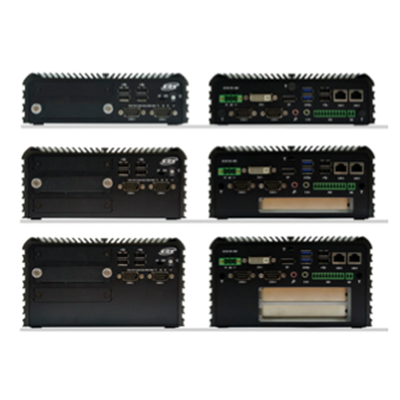A modular approach in modern Fanless PC design delivers flexibility, allowing your OEMs to get your products to market faster. Pre-qualified PC subsystems with comprehensive I/O options will also help OEMs shorten the development cycles as well as improve supply chain efficiency. All of this translates to cost savings and faster time-to-market.
Modular Computer Concept
While it may be gaining popularity, modular design is not new. There are Computer-on-Module (COM) solutions like PC/104, ETX/XTX, COM Express, etc. that all support modular computer design. Systems that required such solutions are typically for embedded applications, requiring longevity and rugged design. Because the development cycles are long, system engineers want to prolong the life cycle of the overall system by using computer modules that can be swapped out when newer technology becomes available. A benefit of modular design is a smaller-scale validation process than would have traditionally been used. This process costs less (time and money) and helps OEMs navigate the technology changes and take advantage of them more immediately. However, solutions like COM were not being offered at the PC subsystem level. This meant that system engineers still needed to design and validate on the PC subsystem level. The process usually involves in selecting required I/O interface and then encasing it in a custom-designed chassis. Afterwards, system engineers were still need to provide an appropriate thermal solution, either using cooling fans or going with a fanless approach. Lastly, the PC subsystem would need to be validated under the design environments, adding to the development schedule and cost. If the PC’s performance does not operate as planned, it will end up causing scheduling delays and increasing the total development cost.
Fanless PC Advantages
Thanks to the technological development of new processors, the new paradigm in PC subsystem design is to offer a pre-configured and pre-validated fanless PC subsystem. The advantages of using fanless PCs are very substantial:
- Less failure and no filters to replace (no cooling fan)
- Greater ingress protection (no ventilation opening)
- Higher reliability and less shock/vibration susceptibility (no moving components)
- Very compact form factor (no internal airflow and cooling fan space required)
All of these benefits are very important in industrial applications; where environmental conditions, like operating temperature, dust, debris, shock and vibration are more stringent than in commercial applications. With the offering of pre-validated PCs from manufacturers, system engineers can now select a
fanless PC with confidence, knowing that it will meet their needs and requirements.

Modular Approach to Fanless PC Design
Embedded applications have all kinds of different requirements. It is important for manufacturers to offer a wide variety of selections so that more applications can be supported. But, this also means that all of the variations need to be validated. A manufacturer’s costs of development can add up quickly if this not planned ahead carefully. The modular approach is a way to maximize flexibility and keep the cost of development for customers , low. The process usually starts with selecting a family of processors with varying levels of performance and similar thermal requirements. Once the processor’s thermal requirement is defined, the next step is to design the appropriate motherboard form factor with the appropriate thermal solution. Usually, an extended temperature range (-20 ~ 70°C) is the target operating temperature for industrial applications. For fanless design, the heat sink will need to stay close to the processor. Since no extra space is required for the cooling fan or air flow, the form factor can be very compact. Following motherboard design, manufacturers can innovate by providing different I/O and expansion options for their clients. This is done via onboard expansion slots (like min-PCIe or the new NGFF). Some of the commonly used I/O options can be developed into standard modules, where they can be mixed and matched depending on the application’s requirement(s). The various I/O options can be COM ports, Ethernet ports, Digital or Analog I/O, CAN bus, etc. Additionally, some manufacturers may define a special I/O connector so that multiple modules can be stacked together without having to use cables for an inter-PCBA connection. Different chassis heights, with the same footprint can be designed to accommodate different numbers of I/O modules inside the chassis. The end products will feature a motherboard and respective thermal solution integrated with the fanless chassis. The advantage of building a product this way is being able to allow for different I/O modules to be configured in order to support many different applications’ I/O requirements.

[Same chassis footprint with different height to accommodate different I/O in modular fanless PC design]
Modular Panel PC
The same concept can be further expanded to Panel PCs. The display module of the Panel PC is a module with a pre-defined display and an I/O connector. Another processor module is attached to the back of the display module and connects the electronics to the display module via the I/O connector. The display module can be in different sizes and implement different touch technologies. The processor module can also support different processors and I/O expansions.
Flexible, Cost-effective and Quick to Delivery
The modular approach in Fanless PC design allows the manufacturers to offer wider selections to support a wide variety of applications. In turn, businesses assume all the benefits of fanless technology and modular design, alike. These benefits include saving space, increased reliability, more economic options and an improved supply chain.

 [Same chassis footprint with different height to accommodate different I/O in modular fanless PC design]
[Same chassis footprint with different height to accommodate different I/O in modular fanless PC design]



